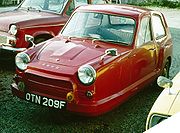
Bond 875
Encyclopedia

Bond Cars Ltd
Bond Cars Ltd was a British car maker. Initially called Sharps Commercials Ltd, it changed its name to Bond Cars Ltd in 1963. The company was taken over by the Reliant Motor Co Ltd of Tamworth, Staffs in 1970 who quickly closed the Preston factory, transferring the spare parts business for the...
in Preston, United Kingdom
United Kingdom
The United Kingdom of Great Britain and Northern IrelandIn the United Kingdom and Dependencies, other languages have been officially recognised as legitimate autochthonous languages under the European Charter for Regional or Minority Languages...
from 1965 to 1970. There was also a van version from 1967, known as the Ranger.
The car was announced in August 1965, though volume production got underway only during the summer of 1966. The 875 used a four-cylinder 875 cc four-stroke engine
Internal combustion engine
The internal combustion engine is an engine in which the combustion of a fuel occurs with an oxidizer in a combustion chamber. In an internal combustion engine, the expansion of the high-temperature and high -pressure gases produced by combustion apply direct force to some component of the engine...
from the Rootes Group. Crucially for the dynamics of the vehicle, this was rear-mounted
RR layout
In automotive design, a RR, or Rear-engine, Rear-wheel drive layout places both the engine and drive wheels at the rear of the vehicle. In contrast to the RMR layout, the center of mass of the engine is between the rear axle and the rear bumper....
, unlike in most other British three-wheelers of the era. It was the same basic layout as used in the Hillman Imp
Hillman Imp
The Hillman Imp is a compact, rear-engined saloon car that was manufactured under the Hillman marque by the Rootes Group from 1963 to 1976...
, installed as a complete package along with the Imps' transmission, rear suspension and rear wheels: however, thanks to the fact that the 875 had a fibreglass body along with aluminium doors, and weighed less than 400 kg (882 lb), the performance was good — better than the Imp. The engine was the low-compression version (compression ratio 8:1) as used in the commercial versions of the Imp – the Commer
Commer
Commer became known in later years as a maker of vans for the British Post Office—particularly the Commer FC which was introduced in 1960 with many body styles, including a 1500 cc van. After engine and interior upgrades it was renamed the PB in 1967 and the SpaceVan in 1974...
van and was able to run on "2-star" low-octane
Octane
Octane is a hydrocarbon and an alkane with the chemical formula C8H18, and the condensed structural formula CH36CH3. Octane has many structural isomers that differ by the amount and location of branching in the carbon chain...
petrol, which was cheaper than varieties used by larger and more highly tuned engines.
The car's light weight enabled it to qualify for motorcycle road tax
Vehicle excise duty
Vehicle Excise Duty is a vehicle road use tax levied as an excise duty which must be paid for most types of vehicle which are to be used on the public roads in the United Kingdom...
rates, and be driven on a motorcycle licence but in order to keep the weight down the interior trim and fittings were minimal.
Racing driver John Surtees
John Surtees
John Surtees, OBE is a British former Grand Prix motorcycle road racer and Formula One driver from England. He was 500cc motorcycle World Champion in 1956 and 1958–60, Formula One World Champion in 1964, and remains the only person to have won World Championships on both two and four wheels...
unofficially broke the saloon car lap record at Brands Hatch
Brands Hatch
Brands Hatch is a motor racing circuit near West Kingsdown in Kent, England. First used as a dirt track motorcycle circuit on farmland, it hosted 12 runnings of the British Grand Prix between 1964 and 1986 and currently holds many British and international racing events...
, managing to attain 100 mph (161 km/h).
Development
A van version, the Ranger, was introduced in April 1967.Styling changes, revised seats, rectangular headlamps and a larger bonnet opening heralded the "Mark II" announced in April 1968. Other changes included the fitting of a heater.
Specification and performance
- Capacity: 875 cc
- Weight: < 400 kg (882 lb)
- 0-60 mph: 16 seconds (car), 14 seconds (van)
- Top speed: 80 mph (129 km/h) (car), 95 mph (153 km/h) (van)
- Fuel economy: 50 mpgimp - 55 mpgimp
- Tyres: Michelin X radial
- Price new: £500
Road Test
The British "AutocarAutocar
Autocar is a weekly British automobile magazine published by Haymarket Motoring Publications Ltd. It refers to itself as "The World's oldest car magazine".-History:...
" magazine tested a Bond 875 in September 1966. The car had a top speed of 82.8 mph (133.3 km/h) and accelerated from 0-60 mph (96.6 km/h) in 22.5 seconds. An "overall" fuel consumption of 34.5 mpgimp was recorded. This put it usefully ahead of the contemporary 850 cc Morris Mini
Mini
The Mini is a small car that was made by the British Motor Corporation and its successors from 1959 until 2000. The original is considered a British icon of the 1960s, and its space-saving front-wheel-drive layout influenced a generation of car-makers...
on maximum speed and acceleration as well as on fuel economy: the car's superior power-to-weight ratio converted into superior performance outcomes. The Bond's £506 manufacturer's recommended price was significantly higher than the £478 price on the Mini, but less than the recommended retail price of £549 for the comparably sized Imp. The testers commended the Bond's performance and economy, but found the three-wheeler unstable at high speed. They thought the gear box and brakes good but were disappointed by 'poor seats and detail finish'.

